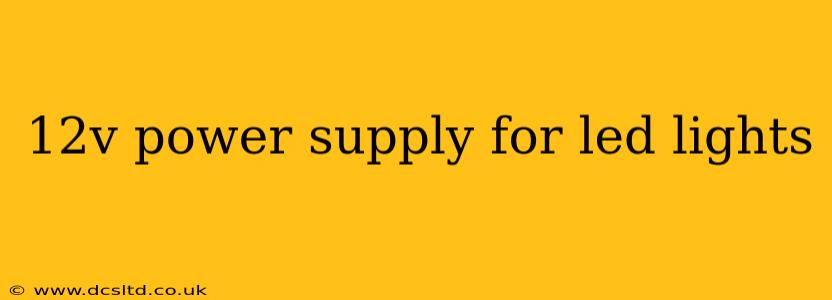Choosing the right 12V power supply for your LED lights is crucial for ensuring their longevity and optimal performance. A poorly chosen power supply can lead to flickering lights, premature failure, and even fire hazards. This guide will walk you through the essential factors to consider when selecting a 12V power supply for your LED lighting project.
What are the different types of 12V power supplies?
12V power supplies come in various forms, each with its own advantages and disadvantages. The most common types include:
-
Wall-wart power supplies: These are compact and convenient, ideal for low-power LED applications like small accent lights or individual LED strips. They are generally inexpensive but might not offer the same durability or power output as other types.
-
Desktop power supplies: Larger and more powerful than wall-warts, these are suitable for higher-power LED systems, such as multiple LED strips or more demanding lighting setups. They often provide better heat dissipation and overall reliability.
-
Enclosed power supplies: These are designed for indoor or outdoor use, offering protection against dust, moisture, and other environmental factors. They are particularly important for applications in harsh environments.
-
Open-frame power supplies: Generally used in industrial settings, open-frame power supplies offer high power output and efficiency but lack the protection offered by enclosed models.
How many amps do I need for my LED lights?
This is a crucial question. Underpowering your LEDs will lead to dim lighting and potential damage, while over-powering them might not necessarily be a problem, but is wasteful. To determine the amperage you need, you need to know the total wattage of your LED lights. The formula is simple:
Amps (A) = Watts (W) / Volts (V)
For a 12V system, if your LEDs consume 60W, you'll need: 60W / 12V = 5A. Always choose a power supply with a slightly higher amperage rating than your calculated requirement. This provides a safety margin and prevents overloading the power supply.
What is the difference between a constant current and constant voltage power supply?
This is a critical distinction. Most LED lights require a constant voltage power supply, meaning the voltage remains consistent regardless of the load. However, some high-power LED systems or individual LEDs might benefit from a constant current power supply, which regulates the current flow to the LEDs. Incorrectly choosing between these types can lead to LED malfunction or damage. Check your LED light's specifications to determine the correct power supply type.
What are the safety considerations for using a 12V power supply?
Safety should always be a top priority. Consider these factors:
-
Overload protection: Ensure your power supply has built-in overload protection to prevent damage from short circuits or overcurrent.
-
Short circuit protection: This critical feature safeguards your lights and prevents potential fire hazards.
-
Proper ventilation: Allow adequate ventilation around the power supply to prevent overheating.
-
Correct polarity: Double-check the polarity (+ and -) markings on both the power supply and your LED lights to ensure correct connection. Incorrect polarity can instantly damage your LEDs.
-
Certification and standards: Choose a power supply that meets relevant safety standards, such as UL, CE, or RoHS.
How do I choose the right size and type of 12V power supply for my LED lights?
The selection process involves several steps:
- Calculate the total wattage of your LED lights.
- Determine the required amperage using the formula: Amps = Watts / Volts.
- Add a safety margin—choose a power supply with a slightly higher amperage rating.
- Consider the environment: Choose an enclosed power supply for outdoor or humid locations.
- Select the appropriate power supply type: Constant voltage is most common for LEDs.
- Verify safety certifications and features.
By following these steps, you can confidently select a 12V power supply that will provide reliable and safe power for your LED lights. Remember always consult your LED lights' specifications for precise requirements.
